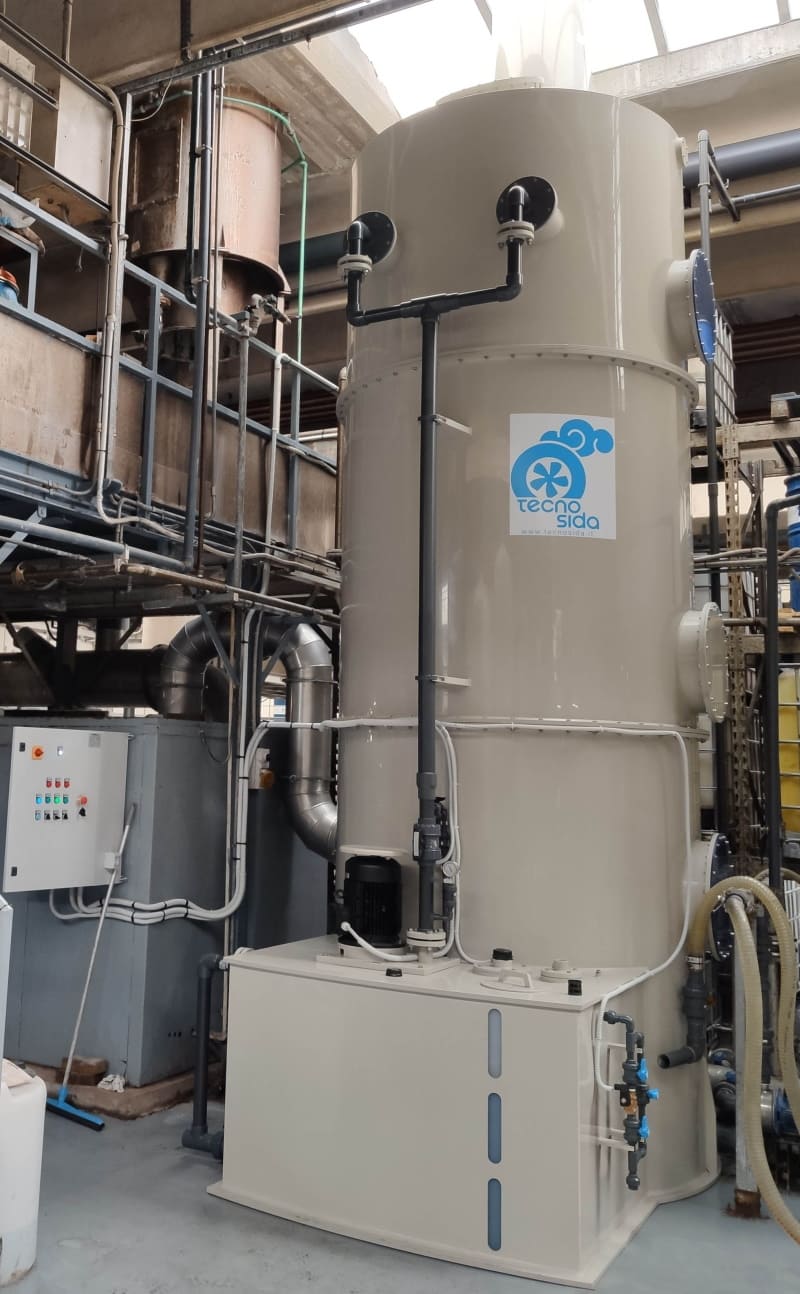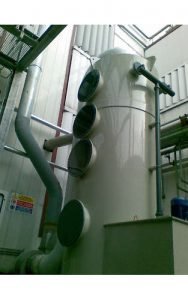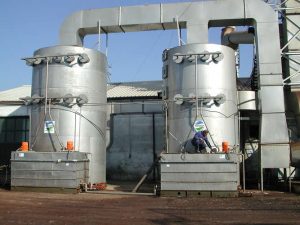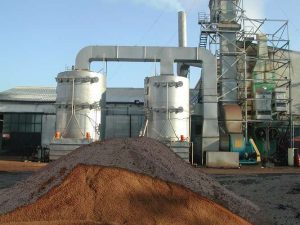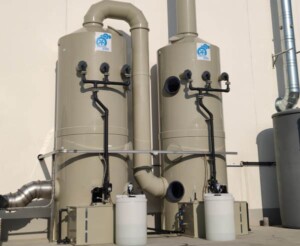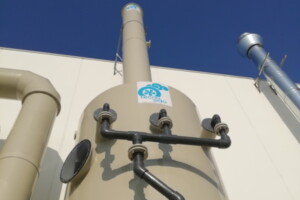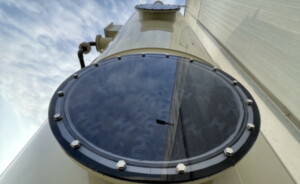Wet Scrubbers Applications for pollution abatement of inorganic compounds, odors and chemicals
Wet scrubbers: four real productions of abatement technologies for inorganic gases and VOCs reduction in the chemical, metallurgic and detergents production industries
The products described below refer to systems made by Tecnosida® in order to reduce the concentration of the VOCs (Volatile Organic Compounds) and VICs (Volatile Inorganic Compounds) in different industries.
The VICs are chemical inorganic compounds having the same physical characteristics of the VOCs, but they are different from them as they do not belong to the organic chemistry. Ammonia (NH3), hydrogen sulphide (H2S) and carbon dioxide (CO2) are some examples of typical VICs.
The VICs, as the VOCs, can be basic (as ammonia), acidic (as hydrochloric or nitric acids gases) or reduced VICs (as hydrogen sulphide) and their concentration can be reduced through the use of scrubbers. According to the type of compounds in the flow to be treated, acidic, base reagents or oxidizing agents, which allow the pollutants to be reduced, are added to the recirculation liquid.
Below some real cases are described.
Application 1: wet scrubber to reduce concentration of VOCs caused by the baking soda production in the chemical industry
The company of this first case deals with the production of baking soda and some chemical compounds which are used in several industries. The different branches in the world even deal with other sectors, producing special plastics material used in the hi-tech market.
The Italian branch of this multinational corporation has contacted us in order to considerably reduce the emission of VOCs in the atmosphere, that are produced during the baking soda production.
Scrubber to reduce the concentration of VOCs
In order to solve the client’s problem and reduce the VOCs emissions, Tecnosida® has designed a scrubber able to considerably reduce the concentrations of molecules in the emission to be treated. In this case a wet vertical scrubber has been used: unlike the horizontal scrubbers, in it the gas flow goes in the lower part of the scrubber in order to be treated, thanks to filling corps that are sprayed with water by the nozzles. The reduction efficiency remains high thanks to the structure of this scrubber, which provides a residence time, a crossing speed and an interface that are suitable for the reduction of the concentration of pollutants in the gas flow.
In this case, upon specific request of the client, Tecnosida® has designed and made the scrubber in order to deliver it to the client pre-assembled with the setting layout. The company made the final installation thanks to the on-site technical support and to the telephone support provided by Tecnosida®.
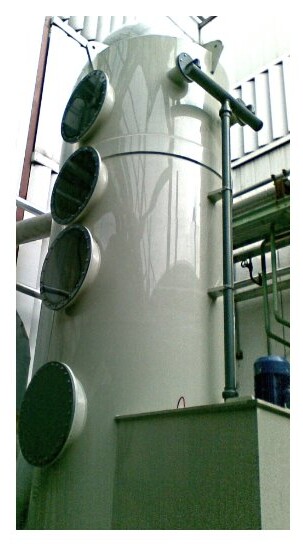
Application 2: wet scrubbers to reduce smell deriving from oils extraction procedures
Our client of this second case is an oil company which deals with olive pomace oil extraction. During this activity, the pomace is not processed in a short time and can remain in stock for several weeks, causing very strong smells which spread throughout the surrounding area.
Due to the location of this company, the smells have created problem with the neighbourhood which asked them to intervene in order to reduce the emission. For this reason, the oil company has contacted Tecnosida® asking for a prompt and effective intervention to solve this problem.
Stainless steel scrubber to reduce the concentration of smell deriving from refined pomace olive oil extraction procedures
After a specific survey at the client’s headquarters, Tecnosida® designs and creates a wet scrubber able to solve this problem. This one is made up of two vertical wet scrubbers having a dosing system of chemical reagents.
As we have seen in the previous case, in the scrubbers the pollutants are reduced thanks to the use of a washing liquid made with water and reagents of different nature.
In this case, the gas flow to be treated is characterized by the presence of acidic substances (hydrogen sulphide, mercaptans, etc.) and biological molecules deriving from pomace process. For this reason, each scrubber has a tank with water in which are added a basic reagent to reduce the concentration of acidic substances and an oxidizing agent to remove the biological molecules and reduce their potentially pathogen microbiological charge. Besides, the tanks are provided with probes to test pH and Redox and to automatically add the related reagent, therefore the recirculation liquid will always have suitable values for the reduction of the concentration of the pollutants there.
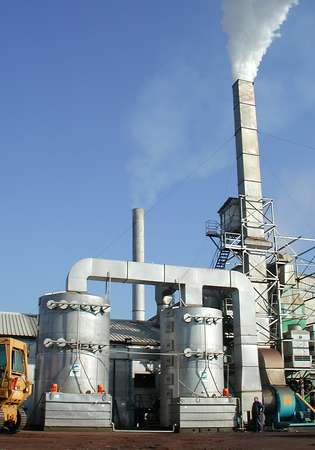
This system is made up of two vertical wet scrubbers, as the capacity of the air to be treated is very high. The system has been made up of stainless steel, in order to ensure higher resistance to the high temperature (over 60°C after the drying rooms, or rather at the entrance of the scrubber). The solution proposed by Tecnosida® allowed the client to solve their problem, reducing the emission of odorous compounds in the atmosphere and eliminating the related complaints.
Application 3: wet scrubber to reduce the concentration of acidic and base gases caused by stainless steel production in the metallurgic industry
In this case we will talk about an Italian metallurgic company specialized in metal finishes and in the production of stainless steel in several colour finishes.
Their products are applied in all the sectors which use stainless steel pieces (design, architecture, construction industry, automotive…). This kind of production includes different procedures which involve the emission in the atmosphere of polluting gases, such as VOCs, VICs and mist.
Our client has contacted us asking for an intervention to reduce the acidic and base gases deriving from the washing procedures of stainless steel slabs.
Abatement technologies: scrubber with two stages to reduce the concentration of acidic and base gases in the production of stainless steel
The working procedure involves the washing of stainless steel slabs through the use of acidic and base reagents. This kind of production is made in booths and involves the emission of pollutants that are sucked through suction hoods. However, the gas flow must be treated before its emission in the atmosphere, therefore the client has contacted Tecnosida® asking for the creation of a suitable scrubber.
Therefore, our technicians have arranged a survey at the client’s headquarters in order to test their needs. Following this first stage, Tecnosida® has designed and created a scrubber with two stages made up of two wet scrubbers. The detailed functioning is below.
The gas flow with acidic and base gases is sucked and carried in the first scrubber, whose washing liquid is made up of water with acidic reagent suitable for the reduction of alkaline compounds, or rather base ones.
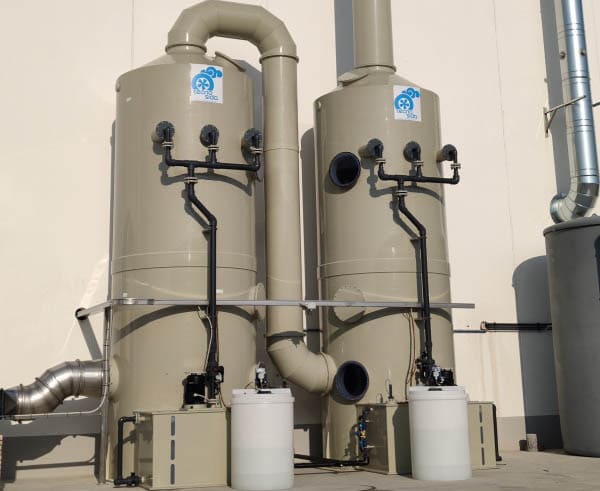
The gas flow full of water goes through a droplet separator before being carried in the second scrubber. This one allows the acidic substances to be reduced before the emission in the atmosphere. For this reason, it has a tank for the soda (base reagent) which is added to water.
The solution designed and created by Tecnosida® has allowed the acidic and base gases to be reduced, therefore solving the client’s problem and reducing the emission within the limits established by Law.
Considering our work and our relationship, the client has then contacted us to create another scrubber. Its description is below.
Vertical wet scrubbers to reduce the concentration of nitric acid gases in the metallurgic industry
The second request from our client was a supply of scrubber able to reduce the nitric acid gases (VIC) emitted during the polishing procedures of stainless steel slabs. This procedure is carried out in containment booths through the use of machines that polish the slabs with an acidic solution with nitric acid at 3÷4%.
Even in this case, Tecnosida® has designed a wet system to reduce the concentration of gases with only one scrubber. In particular, the gas flow is carried inside the scrubber thanks to the stainless steel 316 pipes provided by us, in order to be treated in the scrubber. This one has been designed to reduce the concentration of acidic substances and, therefore, it has a tank for the base reagent. As we have seen in the previous cases, a dosing system allow the water pH to be tested and the base reagent to be added when needed in order to rebalance the liquid values. The water storage and recirculation tank has an automated drain valve to change the liquid once exhausted.
In this product, the conveying pipes have been made with stainless steel 316 to overcome the acids in the flow. On the other hand, the electric panel has an inverter in order to adjust the aspiration system to the real operational needs, thus energetic waste can be avoided.
Application 4: wet scrubber to reduce gases deriving from the production of detergents in the chemical industry
Our client of this last case is a chemical industry that deals with the creation and delivery of cleaning products and professional and industry sanitizing.
During this production stage, in the detergents factory several types of pollutants, such as gases, steams and dust with traces of chlorine, several types of VOCs, phosphoric and nitric acid are emitted.
Therefore, the company got an aspiration system for the emissions from the mixers to treat them in a sort of scrubber. However, as this old plant did not meet the client’s needs, they decided to contact Tecnosida® to ask for an advice.
Wet scrubbers to reduce the concentration of chlorine, VOCs, phosphoric and nitric acid
Following the client’s request, Tecnosida®’s personnel carried out a technical survey at the client’s headquarters in order to test the situation and understand the company’s needs.
In this first stage, Tecnosida®’s personnel established that the current system had to be basically changed by replacing the fan, the scrubber system and the related control panel.
Therefore, Tecnosida® has designed a polypropylene single-stage scrubber suitable for the reduction of the concentration of pollutants in the flow. This scrubber has a new fan located in the current soundproofing booth, in order to reduce the noise.
The system has been completed by providing fitting pipes and an exhaust gas stack.
Thus, Tecnosida® managed to solve the client’s problem and to reduce the costs of the system maintaining the current aspiration system and soundproofing booth.
